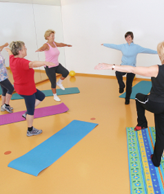Higher Volume Aerobic Exercise for Breast Cancer Patients May Curb Chemo Symptoms
Increased doses of aerobic exercises lasting 50 to 60 minutes were found to be more effective than a standard dose of 30 minutes for managing declines in physical functioning and symptoms such as pain, hot flashes, and fatigue in women undergoing chemotherapy for breast cancer.
Exercises lasting 50 to 60 minutes helped manage declines in physical functioning and symptoms of chemotherapy.

Increased doses of aerobic exercises lasting 50 to 60 minutes were found to be more effective than a standard dose of 30 minutes for managing declines in physical functioning and symptoms such as pain, hot flashes, and fatigue in women undergoing chemotherapy for breast cancer, according to the results a study published recently in the Journal of the National Cancer Institute.
“Exercise helps breast cancer patients cope with treatments, but we don’t know if there is an optimal dose or type of exercise for getting through chemotherapy,” said study author Kerry S. Courneya, PhD, of the University of Alberta, Canada. “Previous studies have compared exercise to no intervention but have not really examined the exercise dose and type question.”
Courneya and colleagues conducted a multicenter trial of 301 patients with breast cancer from Canada. Patients were randomly assigned to three weekly exercise sessions of standard aerobic exercise (25 to 30 minutes), high-dose aerobic exercise (50 to 60 minutes), or 50 to 60 minutes of aerobic exercise with resistance exercise.
The primary outcome of physical functioning was measured by the SF-36 subscale. According to this scale neither the high-dose nor the combined regimens were superior to standard aerobic exercise.
When looking at secondary outcomes of other physical functioning scales, symptoms, fitness, and chemotherapy completions, results differed. High-dose aerobic exercise was superior to standard exercise for the physical component summary, bodily pain, and endocrine symptoms. In addition, high-dose exercise was also superior to combined exercise for bodily pain and had a borderline superiority for the physical component summary.
“The finding that doing more aerobic exercise appeared to be better than adding strength training to standard aerobic exercise was somewhat surprising,” Courneya said. “Conventional wisdom in exercise science is that combined aerobic and strength exercise is optimal for most health outcomes.”
In addition, Courneya said that even the patients in the study believed this.
“Prior to being randomized in our study we asked patients which exercise program they would prefer to do if they had the choice,” Courneya said. “About 80% selected the combined aerobic and strength exercise program suggesting that even they believed it would be the optimal program for helping them through chemotherapy.”
The combined exercise program was found to be superior to the standard regimen for endocrine symptoms and muscular strength, but was only superior to the high-dose regimen for muscle strength.
No differences were found for chemotherapy completion rates between patients assigned to different forms of exercise.
“Higher volumes of aerobic or combined exercise are safe during breast cancer chemotherapy and do not interfere with chemotherapy completion rates or exacerbate any symptoms,” Courneya said. “Clinicians can recommend these higher volume exercise programs to breast cancer patients who are keen to optimize physical functioning and symptom management without concerns for adverse effects, provided the exercise is supervised by a qualified exercise specialist.”
Newsletter
Stay up to date on recent advances in the multidisciplinary approach to cancer.